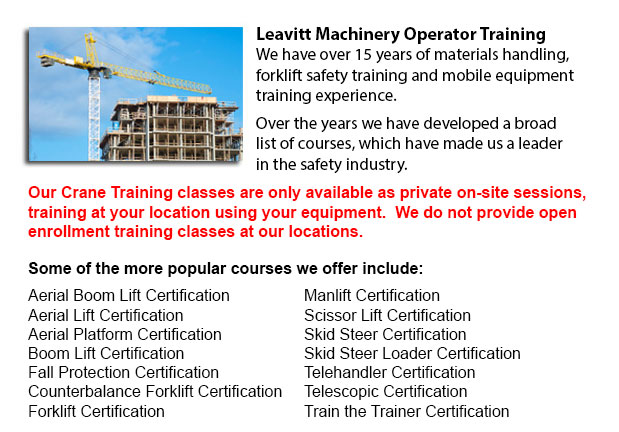
Grande Prairie Crane Operator Classes - For the supervisors and the operators, current and new, the crane operator training course is suitable for all. Course content addresses applicable federal, provincial and state safety regulations. The first component of training comprises complete in-class instruction and exam. Following that is a hands-on customized session along with practical instruction and assessment.
Course content applies to all types and categories of overhead lifting machines. Particular instruction would concentrate on aspects of crane operation used at the workplace of the trainee. Upon finishing the course, trainees would learn how to operate specific overhead lifting machines, attachments and related parts safely and efficiently.
The operator course's goal is to first identify and potentially dangerous operator habits which may develop while a person operates an overhead crane. Costly damage to equipment and products could be avoided with correct practices. Training reduces the chance of a workplace incident or injury occurring.
The course will encompass around eight hours of classroom instruction with a couple of hours of on-site, hands-on, customized training. Participants are graded on their knowledge of training material via an assessment of their practical knowledge and written testing. The minimum acceptable score is 80%.
In the in-class session, participants would be taught applicable guidelines and legislation, causes of occurrences and damages, hazard awareness, internal responsibility, capacity ratings/load weight calculations, basic equipment and design principles, pre-shift equipment inspections, safe hoisting/operating methods, kinds of hardware, equipment applications/rigging, angles and hitches, pedestrian/operator safety, flipping/turning loads safely, hand signals for operators and slingers.
The practical training and evaluation portion of the course must be pre-scheduled. This customized portion of the training will be held at the trainees' facility. The duration of this practical training component is an hour or two. The instructor would train two operators at a time on skills like planning the lift, correct rigging practices and safe operation.
Upon completion of the practical operating instruction and evaluation and the in-class instruction, the trainee will write a test. Signed safety rules would be needed from each and every participant. Individual wallet certificates would be given to trainees who are successful. A framed wall certificate would be provided to the company.
-
Grande Prairie Overhead Crane Safety Training
Grande Prairie Overhead Crane Safety Training - Overhead crane safety training equips operators with skills and knowledge about crane safety measures, accident avoidance, materials handling, and machine and stock protection. Trainees will learn the k... More -
Grande Prairie Crane License
Grande Prairie Crane License - The crane operator needs to have been certified with a crane operator license or certification. To be able to practice as an operator of a crane, the qualifications are considered mandatory. Obtaining a license includes... More -
Grande Prairie Heavy Equipment Training
Grande Prairie Heavy Equipment Training - The two most common types of heavy equipment training are classed into the categories of machines; equipment which is fashioned with rubber tires or those with tracks. The tracked vehicle are heavy duty machi... More -
Grande Prairie Skid Steer Ticket
Grande Prairie Skid Steer Ticket - On a skid-steer loader, the lift arms are beside the driver along with pivot points at the back of the driver's shoulders. This makes them different compared to a conventional front loader. Because of the operator's... More -
Grande Prairie Zoom Boom Ticket
Grande Prairie Zoom Boom Ticket - Zoom Boom Training is intended to train operators on variable reach forklifts. The objectives of the training are to impart an understanding of the physics of the equipment, and to be able to outline the operator's t... More -
Aerial Lift / Boom Lift / Man Lift / Scissor Lift Certification in Grande Prairie
Scissor lifts are lift truck tables that raise materials and people and supplies vertically. They are usually used in commercial, industrial and construction environments. A common use of scissor hoists is for lifting or lowering construction supplie... More -
Grande Prairie Aerial Lift Safety Training
Grande Prairie Aerial Lift Safety Training - Each and every year, there are roughly 26 construction fatalities due to the utilization of aerial lifts. Most of the craftsmen killed are laborers, electrical workers, ironworkers, carpenters or painters.... More -
Grande Prairie Fall Protection Ticket
Grande Prairie Fall Protection Ticket - The number one reason of death within the construction business come from fall-related incidents. There is more chance for fall accidents depending upon the kinds of work being done in your workplace. Therefore... More

Forklift Certification Grande Prairie
TOLL FREE: 1-888-254-6157
Grande Prairie, Alberta
forkliftcertificationgrandeprairie.com
Email Us
About Us


